How Norv Turner has revamped the Carolina Panthers' offense
When the Carolina Panthers hired Norv Turner this offseason as their new offensive coordinator, the move set up a potentially fascinating marriage of play-caller and pivot.
Turner has spent 27 years in the NFL as a head coach or coordinator, primarily relying on offensive schemes and passing concepts from the “Air Coryell” system, which is predicated heavily on a vertical passing game. While Cam Newton certainly has the arm strength and velocity to operate in such a system, initially it looked like the Panthers’ roster might not have the right weapons to support the quarterback and help him succeed with Turner's playbook.
But an evolution in Turner’s offensive philosophy can be seen when watching the Panthers this season. Some of the vertical concepts are still in place, as a zebra doesn't change its stripes overnight. However, Turner has done a great job of using what's available to him and designing plays that get his best players in space, all while still stressing a defense at every level of the field.
One of Carolina’s touchdown drives during the team's Week 8 victory over the Baltimore Ravens provides a wonderful example of how Turner is evolving as a play-caller, and how that's paying off for the Panthers.
Play No. 1
First-and-10, ball on Carolina's 46-yard-line
The Panthers put Newton in the shotgun to start the drive and use 11 personnel, with three wide receivers and a tight end joining the passer.
They line up with two pass-catchers on each side of the field. Tight end Greg Olsen (No. 88) is in a tight alignment on the right side, and D.J. Moore (No. 12) is in the left slot:
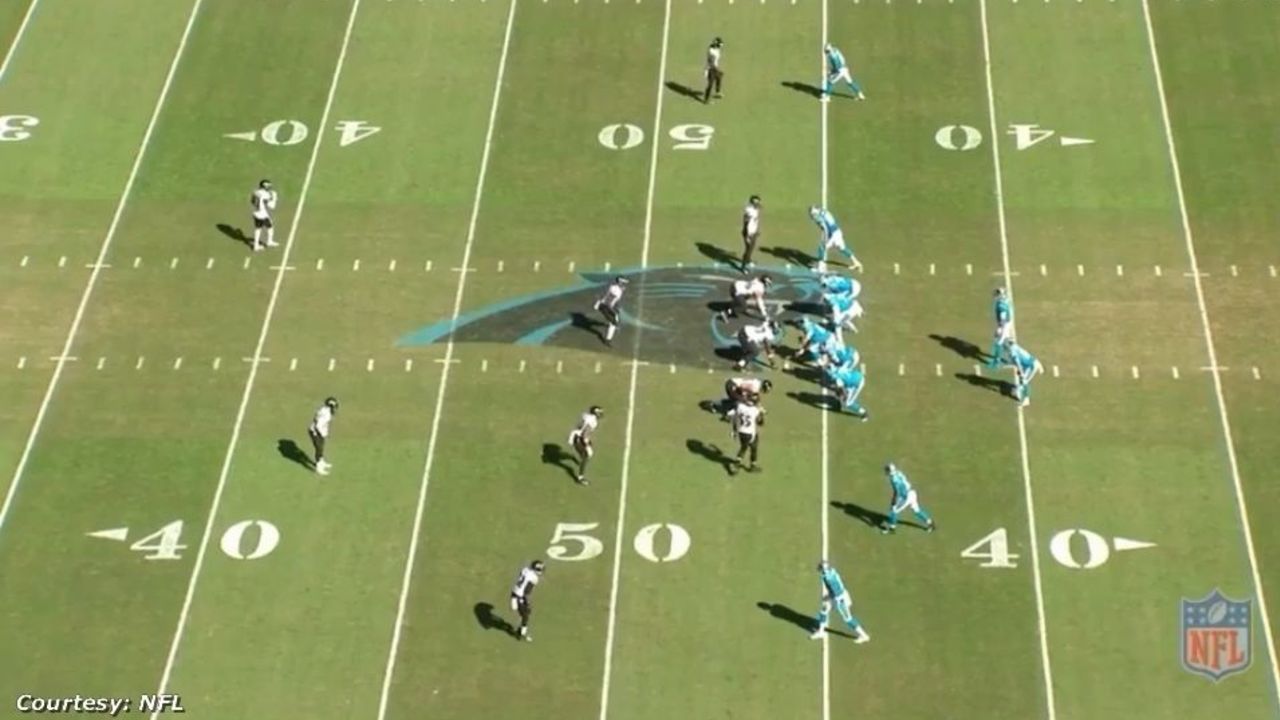
Here is the play Turner calls:
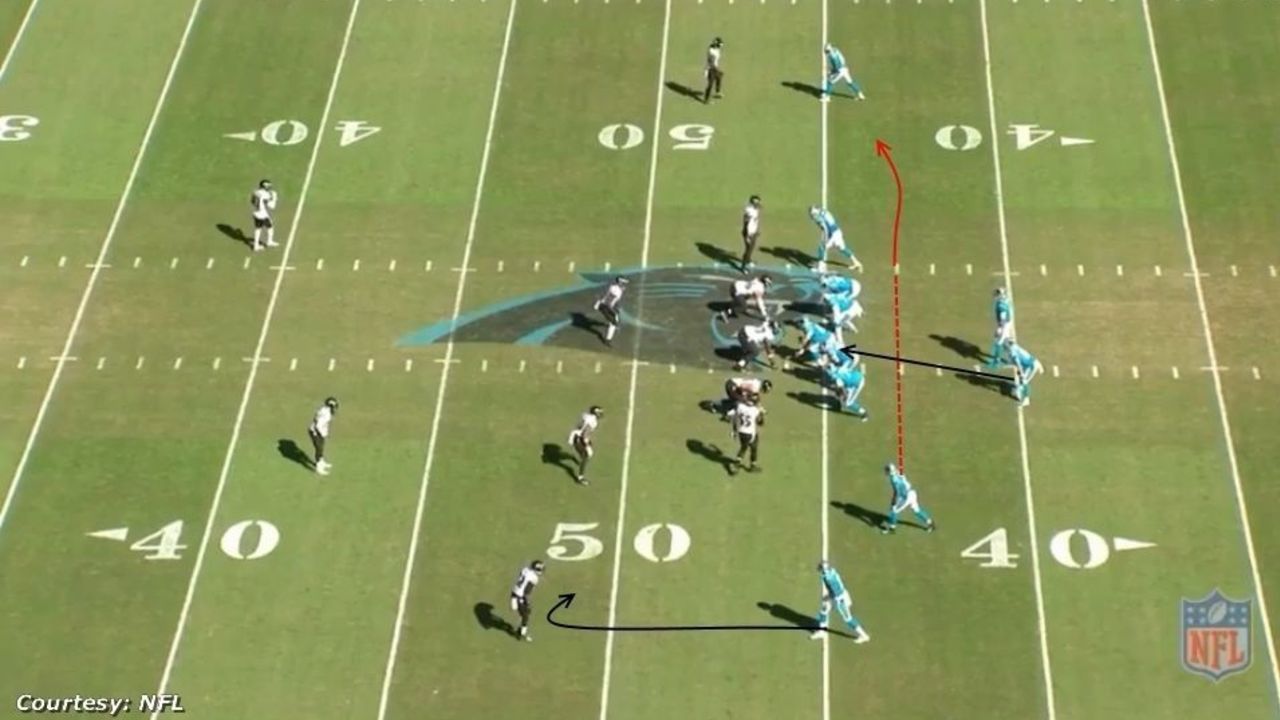
The Panthers run a play-action passing play with a run-pass option element. Newton fakes a handoff to Christian McCaffrey, then looks to throw a backside hitch route to Devin Funchess (No. 17).
But as Newton flashes his eyes to the left, he sees cornerback Jimmy Smith (No. 22) jumping the route. So the QB moves on to Plan B, which is Moore on a swing route after the wideout completes his motion across the formation:

Think about how this play impacts Baltimore's second-level defenders. First, the Panthers show a potential run on the fake handoff to McCaffrey. Then Newton looks to his left, making the defenders think a pass will go in that direction. Finally, the quarterback goes to his third option, the swing route to Moore on the right side.
From inside, then to the left and right, the Panthers’ offense stretches Baltimore's defense on this play while giving Newton two potential short throws that have a high possibility of completion.
To top it all off, Moore catches the pass in the right flat and is working against linebacker Matt Judon. That's a matchup the Panthers will take on every snap. Moore puts a move on the defender and picks up seven yards, putting Carolina in a very manageable second-down situation.
Play No. 2
Second-and-3, ball on Baltimore's 47-yard-line
On second down, the Panthers change things up, switching to a 21 personnel package with two running backs. They add C.J. Anderson (No. 20) and put him in the backfield next to Newton, who is in the shotgun.
McCaffrey starts the play aligned as a receiver on the right, but then he goes deep into the backfield and to the left through orbit motion:

Here is the offensive design Turner dials up on second down:

Carolina uses some misdirection here to again trick the eyes of the Ravens’ linebackers and get them moving away from the intended targets on the play. Newton and Anderson fake an outside zone running play to the left, and the Panthers’ offensive line moves in that direction to sell it.
The design also features the threat of McCaffrey on a deep swing route to the left. But that's all “eye candy” to confuse the defense, because as Newton pulls out of the fake to Anderson, he rolls to the right and sees three receivers on that side of the field.
Newton is pressured off the edge, but he finds Moore on a shallow crossing route for another easy throw and a quick gain upfield, giving the Panthers a first down:

Again, the Panthers gave Newton a higher-percentage throw through their use of misdirection. Turner also put Moore in open space and in position to succeed after the catch.
Play No. 3
First-and-10, ball on Baltimore's 29-yard line
Having used misdirection, play-action, and shorter throws on the first two plays, Turner now turns to his roots and calls a vertical pass.
The Panthers line up again with two running backs on the field, but this time they use a pistol formation with McCaffrey behind Newton, and Anderson standing to the right of the quarterback. Olsen aligns in a wing to the left:
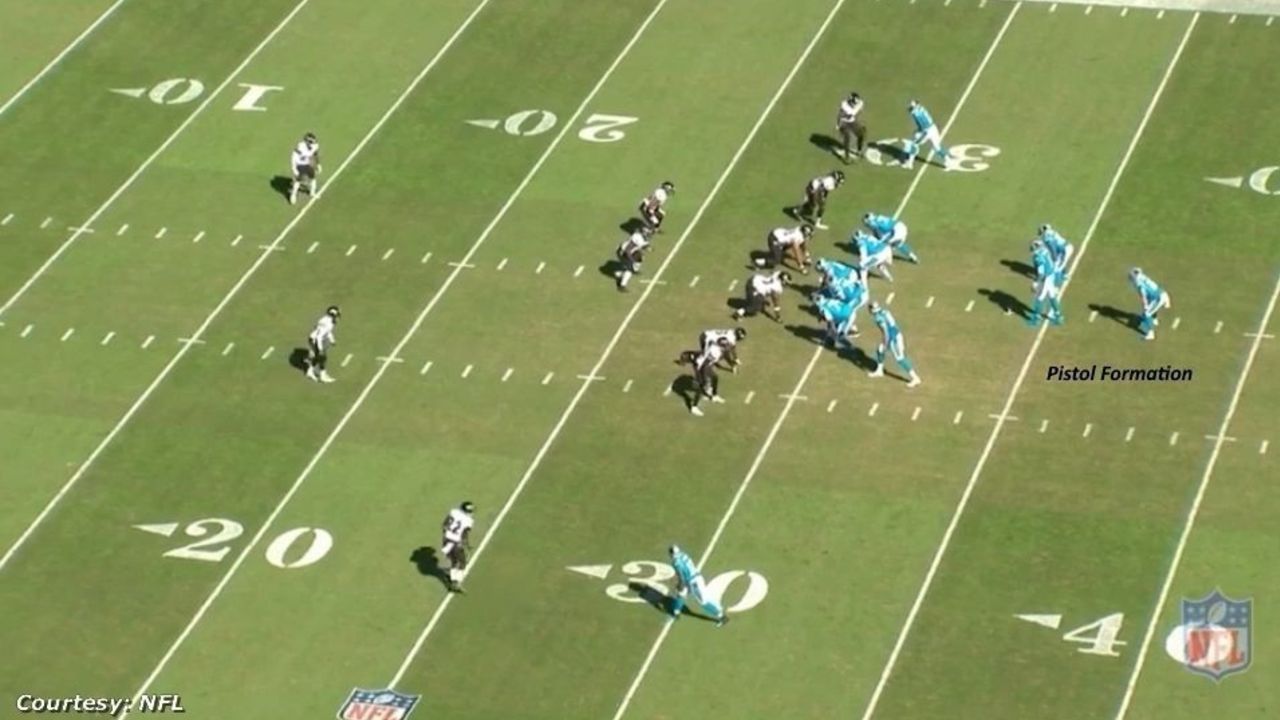
The Panthers show a split-zone running look, with Olsen executing a cross block from left to right as Newton makes a cursory inside-run fake to Anderson. McCaffrey runs another deep swing route to the left side.
All of this is done to confuse the defense. But this time, instead of attacking short, the Panthers push the ball downfield:
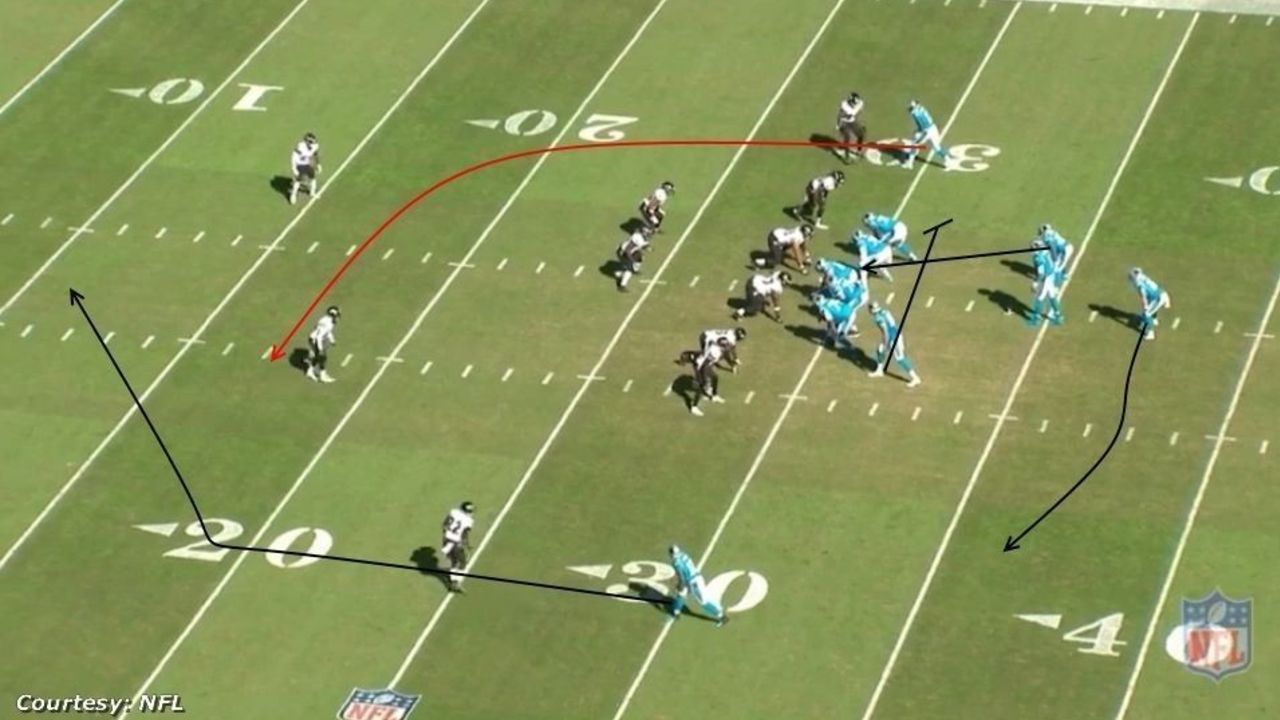
The play design here is the Yankee Concept, a vertical passing play that combines a deep post route with a crossing route at the intermediate level of the field.
Many NFL teams are using this design, and here, after stressing the Ravens’ defense near the line of scrimmage on the previous two plays, the Panthers attack downfield:

Newton finds Funchess on the crossing route, and he makes a good anticipation throw as the receiver comes across the field. The Panthers catch the defense in a single-high coverage look, and with the free safety dropping to take away the deep post route, Newton makes the right decision.
Now Carolina is on the Ravens' 10-yard line and deep in the red zone.
Play No. 4
First-and-10, ball on Baltimore 11-yard line
After calling three straight pass plays, Turner decides to keep the ball on the ground to close out this drive. For the first time on this series, Newton lines up under center, and yet again the Panthers use a different offensive personnel package:
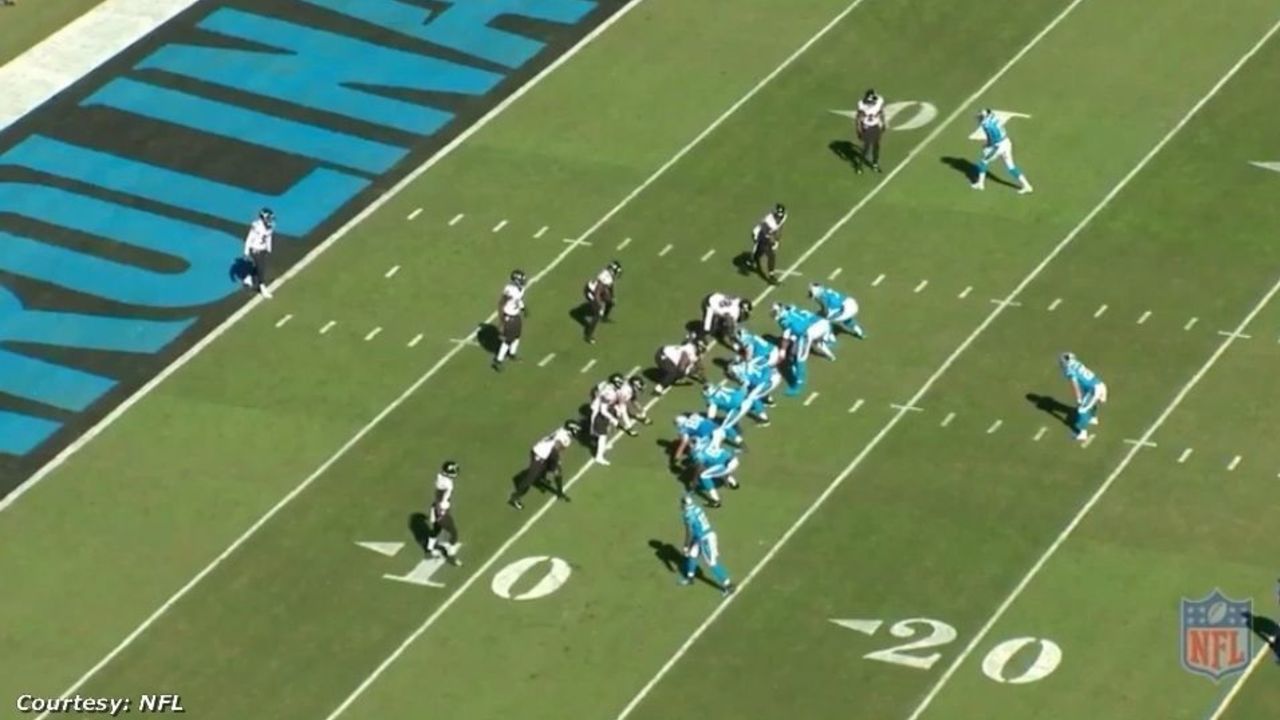
The Panthers bring two tight ends into the game and use 12 personnel. They align with both tight ends to the left, and with McCaffrey as the single back behind Newton.
Carolina showed zone running play looks previously, and the split-zone design is what Turner draws up here:
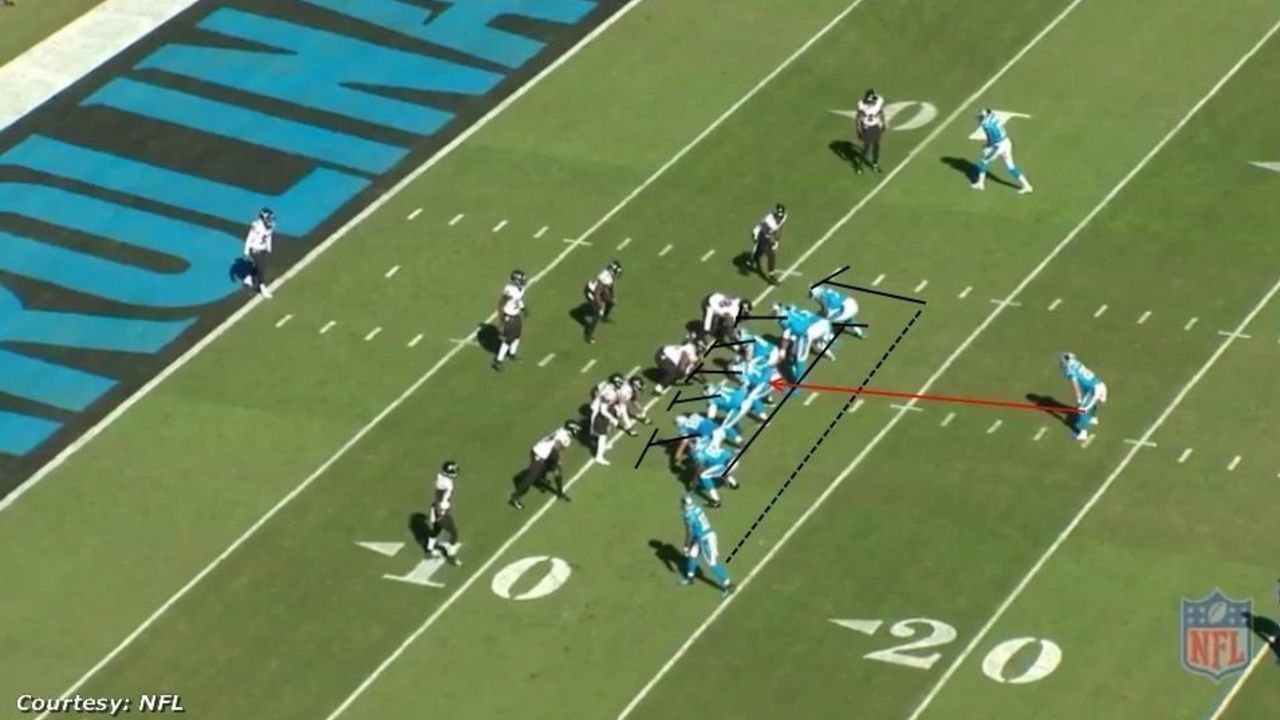
Moore comes across the field in pre-snap motion, and as the play begins, tight end Chris Manhertz (No. 82) executes the cross block, working left to right. The offensive line flows in unison to the left at the snap on a zone-blocking design.
Baltimore, however, gets some quick interior pressure, forcing McCaffrey to stop in the backfield. That's usually a death knell for a running play, but with McCaffrey's vision and quickness, the second-year back turns lemons into lemonade:

McCaffrey bounces to the outside and scampers into the end zone for the touchdown.
The Panthers' quick scoring drive provides a great glimpse into how much Turner has changed his offense. While traditionally a vertical-based play-caller, Turner has added a focus on short and intermediate passing to Carolina’s playbook.
There's a dual benefit to that approach. It gives the Panthers some routes and throws with a higher likelihood of success, and it also puts players like Moore and McCaffrey into space working against linebackers.
The NFL is a matchup league, and teams need players who can win one-on-one. When a coordinator can get someone like Moore matched up in space against a linebacker like Judon, the offense has a better chance to succeed.
Turner remains a coach with the desire to push the ball downfield, and as we saw on the third play of this drive, the Panthers can take deep shots while incorporating play-action and misdirection to confuse defenders.
Turner has adapted, combining his old ways with some new-found creativity. The result has been a 6-2 record, putting the Panthers among the NFC's top teams.
Mark Schofield writes NFL feature content for theScore. After nearly a decade of practicing law in the Washington, D.C., area Mark changed careers and started writing about football. Drawing upon more than a decade of playing quarterback, including at the collegiate level, Mark focuses his work on quarterback evaluation and offensive scheme analysis. He lives in Maryland with his wife and two children. Find him on Twitter @MarkSchofield.